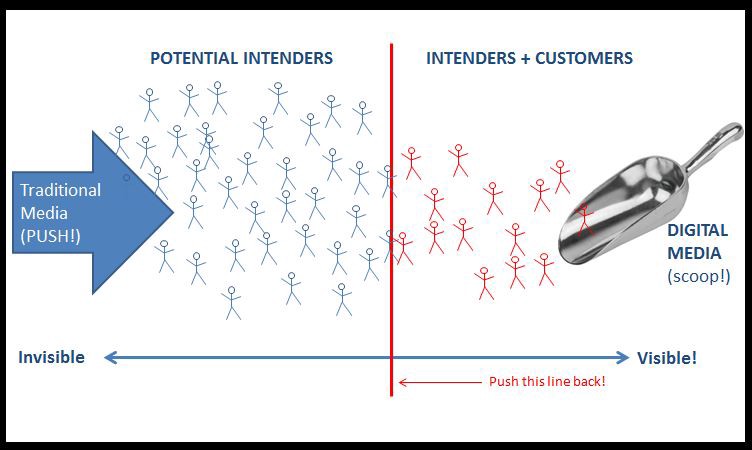Published when I believed media could help us solve things. NOVEMBER 29, 2013
The large majority of marketers put a ton of money into traditional marketing channels, using “branding media” to drive interest in their products. Later, they allocate digital budget for “scooping them up” with retargeting and other cookie-based targeting tactics. After all, “intenders” have already raised their hand digitally, making them easy to find. They already have expressed an interest in the marketers product by visiting the website, leaving something in a shopping cart, or just “looking like” the typical customer. In the classic “AIDA” funnel, the “Awareness” budget at the very top of the funnel rarely gets any digital allocation.
Maybe this is 100% backwards.
Television advertising is about creating enough buzz to drive customers towards Interest, Desire, and Action. TV, radio, and print do this fairly well at scale. Media is easy to buy, has mass reach, and relatively standard creative formats, which lower the cost of broadscale market penetration. But that is changing. Traditonal media is losing people’s attention, which is becoming increasingly divided between mobile, tablet, and desktop screens. Folks are using the DVR and Netflix to avoid marketing altogether, and forget about the kids. You have to basically trick them with “native” ads or actually produce a buzzworthy YouTube video to get their attention. That’s impossible to scale.
What about digital approaches to branding? Can you actually create customers in digital, rather than just scooping them up with retargeting and other lower-funnel tactics? The answer is yes…with the right way to measure. Cookie-based measurement will always fail to give the progressive marketer the right answers. Common issues (deletion, do-not-track, multiple-device, etc.) mean we can only see 30% of online conversions from a particular campaign — never mind the offline sales digital receives 0% attribution for.
What if we used the right metrics, which could reveal the real impact digital branding has on new customer creation? One of those metrics is profit optimization: the concept of understanding what a products optimal sales should be in one geo-targeted area. In other words, understanding how many ACME widgets are selling in Huntington, New York — and how many it should be selling, based on its profit potential. If you understand those numbers, even at a basic level, you can actually start to measure digital success and uncover the “invisible” digital customers you might have. They are the people you can’t see online — because they don’t actually exist (as cookies) yet.
It’s a pretty simple equation: more and more time is spent online. But more sales occur offline. Looking at the graphic above, the concept is to try and pull the digital line backward, and engage the customers you can’t see online, leveraging digital media tactics for branding. By taking a pure digital approach in discrete markets, and measuring by nothing but profit optimization, you will be able to quickly see the hidden power of digital branding — and start creating more customers with digital, rather than marketing to those who have already expressed interest in your products.




